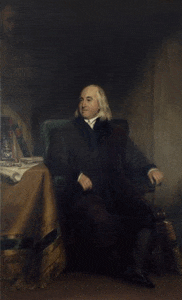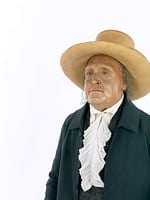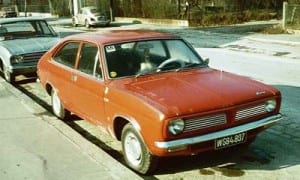The Travels of Jeremy Bentham
By Nick J Booth, on 23 April 2013
We recently updated our Bentham webpages on the UCL Museums site. Among the new features is a conservation page that lists all the known inspections of the auto-icon; a Myth and Legends page that deals with some of the more popular stories concerning the auto-icon; and a new History page. This last one features a couple of pieces of data visualisation that we have tried out. This blog focuses on one of these, a Google map that shows how far Bentham and his auto-icon have traveled.
All the information used here can be found on a downloadable spread sheet on the History Page of UCL Museums website on the auto-icon of Jeremy Bentham. All distances are as-the- crow-flies, and are likely to be an underestimate.
The auto-icon of Jeremy Bentham resides in the South Cloisters of the Wilkins Building at UCL. Although he looks pretty sedate now, he only arrived in this location after the Second World War, and has in the past has been to a number of locations in London, and even out of the country (twice).
View Bentham’s Post-Mortem Travels in a larger map
Jeremy Bentham Died on the 6th June, 1832, at his house in Queens Square Place, London. He was 84. His friends followed the instructions in his will and his body was taken under charge by his Dr Southwood-Smith and delivered to the Webb Street School of Anatomy and Medicine, Southwark (From Death to Dissection, a distance of 2.26 miles). Here Bentham was dissected in front of his friends and disciples by Southwood-Smith , appropriately enough during a lightening storm. It must have been quite a sight!
After the dissection the body was prepared by Southwood-Smith, or at his direction (we aren’t sure which), presumably at the Webb Street School. The skeleton was de-fleshed (though not completely, there is still a greasy feel to it) and articulated with copper wire and pins. Then it was moved to the doctor’s medical practice, at 36 New Broad Street (From Dissection to Display, a distance of 1.49 miles).
It stayed with the doctor even when he moved his consulting rooms, at an unknown date, to 38 Finsbury Square (From House to House, 1271 feet).
In 1850 Dr Southwood-Smith wanted to retire, and offered the auto-icon to University College London. It was accepted and moved from his home in Finsbury Square to a temporary storage location (we aren’t sure why) at 36 Percy Street (From Doctor to Temporary Home, 2 miles). From there it made the 2363 foot journey to University College London (From Temporary Home to Spiritual Home) . It is assumed it came to the Wilkins Building, and the distance is correct to the domed roof.
So from Jeremy Bentham’s death in 1832 until his arrival at UCL in 1850 his body / auto-icon had travelled a total of at least 6.44 miles, presumably by hand and cart, had crossed the Thames twice and stayed at 5 locations. His exact location within UCL is unknown, however Dr Southwood-Smith complained in 1857 that “no publicity is given to the fact that Bentham reposes there in some back room. The authorities seem to be afraid or ashamed of their own possession.”
The next recorded location of the auto-icon is during an 1898 inspection, when he was located in the Anatomy Museum, which at that time was housed in the area to the north of the Flaxman Gallery in the Wilkins Building, now part of the library. The Museum moved from this location prior to 1907. In 1926, on the university’s centenary, he is recorded as having been moved into the custody of the Library. However we don’t know if this was a physical or an admin move…perhaps a bit of both?
The next time we know for certain that the auto-icon moved was at the start of the Second World War (1939) when he was moved out to Stanstead Bury, Standstead Abbotts, near Ware (From UCL to Country Retreat, 38 miles return trip). It’s a good thing that he did as many of the UCL buildings were badly damaged in the Blitz.
On his return he was temporarily stored in the Professors’ Common Room in the Wilkins Building. Common rooms were segregated until 1969 so it is assumed that he was kept in the male common room, rather than the female. From here he was moved to his current position in the South Cloisters (From Common Room to Cloister, 362 feet).
In a 95 year period the auto-icon moved an approximate total of 38.07 miles, for the first time moving outside London (presumably traveling by automobile for the first time) and surviving two world wars.
After coming to rest in the South Cloisters, the auto-icon seems to have had a fairly sedentary life, with the possible exception of having its head stolen (see here for evidence of this brutal crime). This has not been formally recorded in the history of the auto-icon because we are still waiting for confirmation of when and how (and indeed if) this actually happened. It is possible this has led to the myth that the ‘real’ head was stolen and found in a luggage locker in Aberdeen.
In 1981 the auto-icon was moved from its location in the cloisters to the Textile Conservation Centre, then housed at Hampton Court Palace, for treatment to its clothes (From Cloister to Palace, 24 Miles return). One of the staff who did this remembers driving him down Marylebone road in a red Marina Car, sitting on the back seat (still in his chair) covered in a sheet.
The next two recorded movements of the auto-icon are the largest by distance and mark the first time that the auto-icon was put on public display outside of UCL since 1850. In 1992 the wax head and clothes (but not the skeleton) were loaned to the Villa Hugel, near Essen in Germany, an approximate trip of 616 miles return (From Cloister to Villa). Then again in 2002 the same items were lent to (coincidentally) the Ruhrlandmuseum in Essen (From Cloister to Ruhrlandmuseum, 614 miles).
Following on from the auto-icon’s trips to Germany it was next moved to the English Heritage real time x-ray facility at Fort Cumberland, Portsmouth (From Cloister to Fort, 128 mile return). This marks the last time the auto-icon travelled outside UCL, and since 2002 he has only moved a combined total of 308 feet (From Cloister to Garden Room and From Cloister to Geology Museum) for a couple of inspections and photo opportunities.
From 1945 until the present day the auto-icon has travelled a total of 1,382.06 miles, been to Germany twice, been x-rayed by the sea and been inspected at least three times in three different locations. He has travelled by automobile and plane, but sadly (as far as we know) not by train.
In all, the mortal remains of Jeremy Bentham (full body and auto-icon) have travelled approximately 1426.57 miles since his death. They have left London four times, twice to Germany and once each time to Hampshire and Hertfordshire. In life Jeremy Bentham visited Russia via Nice, Florence, Constantinople, and then by sea to the Crimea, before going overland to Krichev (the journey took seven months), and also travelled across Northern England between 1814 and 1818. It seems reasonable to assume that his auto-icon still has a way to go before it travels greater distance than Bentham himself, but perhaps one day…
The UCL Museum Webpages can be visited here, and the spread sheet giving the known history of the auto-icon can be found on this page. We are always looking for interesting ideas for data visualisation. Think you can do something good? Let us know!
5 Responses to “The Travels of Jeremy Bentham”
- 1
-
2
carlos roces felgueroso wrote on 31 January 2014:
I was in the UCL , from 1961 to 1964.
Realy… was the Jeremy Bentham’s icon temporarily stored in the Professors’ Common Room in the Wilkins Building? Common rooms were segregated until 1969 so it is assumed that he was kept in the male common room, rather than the female. From here. was he moved to his current position in the South Cloister?
-
4
Daniel wrote on 6 October 2014:
It could be asked as to how this maximises “utility” for the students at the university! Very interesting article though.
-
5
Bentham ‘present but not voting’ | UCL UCL Museums & Collections Blog wrote on 8 October 2014:

[…] future. All I need to do now is update our documentation and archive, and our web pages, plus a past blog. Oh and […]
 Close
Close





I remember very well, 50 yeas ago, the Jeremy Bentham`s auto icon in the UCL corridor. The passage where we used to take our cup of tea.